The OnLogic Helix HX500 Review: A Rugged Fanless 35W mini-PC
by Ganesh T S on September 17, 2021 10:00 AM EST- Posted in
- Systems
- Intel
- Fanless
- Industrial PC
- Passive Cooling
- Comet Lake
- OnLogic
BAPCo SYSmark 25
The OnLogic Helix HX500 was evaluated using our Fall 2018 test suite for small-form factor PCs. In the first section, we will be looking at SYSmark 25.
BAPCo's SYSmark 25 is an application-based benchmark that uses real-world applications to replay usage patterns of business users in the areas of productivity, creativity, and responsiveness. The 'Productivity Scenario' covers office-centric activities including word processing, spreadsheet usage, financial analysis, software development, application installation, file compression, and e-mail management. The 'Creativity Scenario' represents media-centric activities such as digital photo processing, AI and ML for face recognition in photos and videos for the purpose of content creation, etc. The 'Responsiveness Scenario' evaluates the ability of the system to react in a quick manner to user inputs in areas such as application and file launches, web browsing, and multi-tasking.
Scores are meant to be compared against a reference desktop (the SYSmark 25 calibration system, a Lenovo Thinkcenter M720q with a Core i5-8500T and 8GB of DDR4 memory to go with a 256GB M.2 NVMe SSD). The calibration system scores 1000 in each of the scenarios. A score of, say, 2000, would imply that the system under test is twice as fast as the reference system.
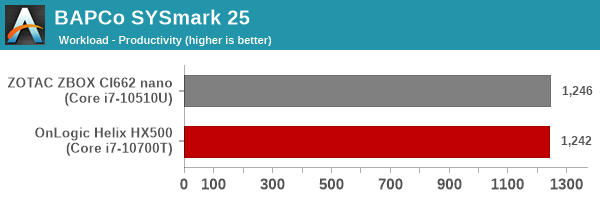
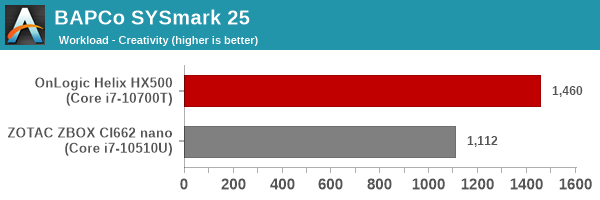
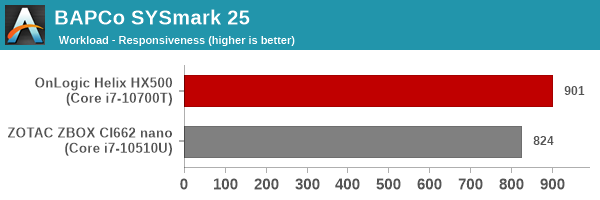

SYSmark 25 also adds energy measurement to the mix. A high score in the SYSmark benchmarks might be nice to have, but, potential customers also need to determine the balance between power consumption and the efficiency of the system. For example, in the average office scenario, it might not be worth purchasing a noisy and power-hungry PC just because it ends up with a 2000 score in the SYSmark 2014 SE benchmarks. In order to provide a balanced perspective, SYSmark 25 also allows vendors and decision makers to track the energy consumption during each workload. In the graphs below, we find the total energy consumed by the PC under test for a single iteration of each SYSmark 25 workload. For reference, the calibration system consumes 8.88 Wh for productivity, 10.81 Wh for creativity, and 19.69 Wh overall.
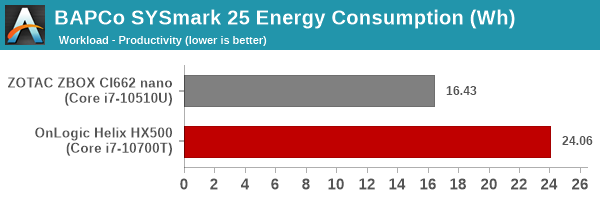
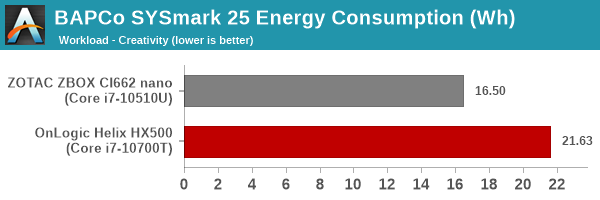
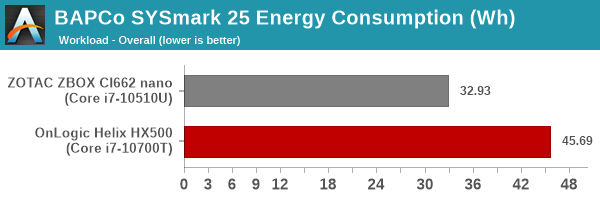
The only aspect common to both the Zotac ZBOX CI662 nano and the OnLogic Helix HX500 is the fact that they are both fanless. The TDPs are different - 15W vs. 35W, and the performance differences are glaring too - 6 cores clocked low in the ZBOX compared to the 8 in the HX500. Given these aspects, the fact that the HX500 surpasses the ZBOX CI662 nano in both overall score and energy consumption is no surprise.










32 Comments
View All Comments
Oxford Guy - Friday, September 17, 2021 - link
130W with a 120W adapter.Thermal throttling.
Double failure.
Oxford Guy - Friday, September 17, 2021 - link
138W.Wrs - Saturday, September 18, 2021 - link
No issue there. Adapter is rated for DC output; review measured AC input “at the wall.” 120 into 138w is 87% efficient. We don’t actually know the system was pulling the full 120w DC. The fanless system obviously cannot dissipate that sustained, but settles in the 50-55w range, 60w at the wall. That’s how modern CPUs work. They idle cold, blow past the normal power budget for load and then settle closer to rated power when things warm up.Oxford Guy - Saturday, September 18, 2021 - link
Ok. Thanks for the clarification.So, it's only a single design failure then (thermal throttling).
My view of thermal throttling is that it should only happen as a preventative measure to keep a system from being ruined due to user error (such as letting a machine become clogged with dust).
Otherwise, you're clocking the chip wrong or doing something else wrong with the design. Stuffing 14nm into a passive case in 2021 probably is part of the mistake.
But, for tricking people with numbers I guess hiding the real performance behind a shifting facade of throttling is fun.
Wrs - Sunday, September 19, 2021 - link
So there is normal throttling and then there is emergency throttling or sometimes shutdown. The CPU is rated for 35w, even though the same silicon is known to be capable of 65 or 95w. What they do is as long as all the temperatures are cool, they let the silicon use 60w+ for a few seconds. This can happen in a laptop, or in this industrial enclosure. It makes it feel just as fast as a desktop, but it can’t last for a heavy sustained workload because of heat buildup. After it warms up, it goes back down to the voltage and frequency it was designed to sustain.It has nothing to do with 14nm. My 7nm desktop works similarly. In 2021 Intel’s got 10nm for low-power (that’s what all Tiger Lake laptops are), but OnLogic was too cheap for that or figured their clientele doesn’t want the latest and greatest. Their case successfully prevented the 35w chip from emergency throttling, so it passed the thermal design test in my book.
Oxford Guy - Sunday, September 19, 2021 - link
Marketing magic to try to justify inadequate cooling. Not a fan.Wrs - Monday, September 20, 2021 - link
I mean, it is a fanless, almost sealed enclosure the size of a standing router or cable modem - how much more can you expect? The benchmarks were more than fine. They way outclassed the Zotac, which is also fanless and the size of a router, but uses commodity plastic hole vents which would be wholly inappropriate in industrial settings but would be suitable as a living room htpc. The OnLogic system gets close to 80c peak on the case; one would hope for the sake of longevity that they used high temperature components throughout and that would be the reason for the high price.Potential improvements are obviously a finer process node like Tiger Lake or one of the Zen 3 laptop chips, a low-power specialized fab node... but all that R&D takes time and $$. The world isn't perfect and we don't have infinite population.
Oxford Guy - Tuesday, September 21, 2021 - link
‘how much more can you expect’I expect parts to match the capability of the cooling versus putting too-demanding parts into a box and relying on throttling. If the parts need a larger heatsink box then use that or choose less demanding parts.
The only exception is turbo that is designed to safely ‘overclock’ a chip if the cooling is better than the norm. That is a good feature.
Wrs - Tuesday, September 21, 2021 - link
As far as I can tell the parts match very well. All the CPU choices for the little box top out at 35w. Obviously the 138w momentary draw came from turbo; there is no separate GPU. The review found the junction temperature under sustained load hit 98C which is just under the throttling temp of 100C. A 15w chip would have undersold the capabilities of the design, and a 65w+ desktop part would have been throttled under sustained load unless perhaps operating out of Antarctica…That’s not to say some won’t take issue with the incomplete seal, or that there might be component longevity issues down the road which is where a warranty comes in.
Jonny314159 - Friday, September 17, 2021 - link
Any VRM cooling on this? I think I see a thermal pad for the SSD, but the VRMs will be a long term point of failure running in a sealed box with no conductive path to the heatsink.